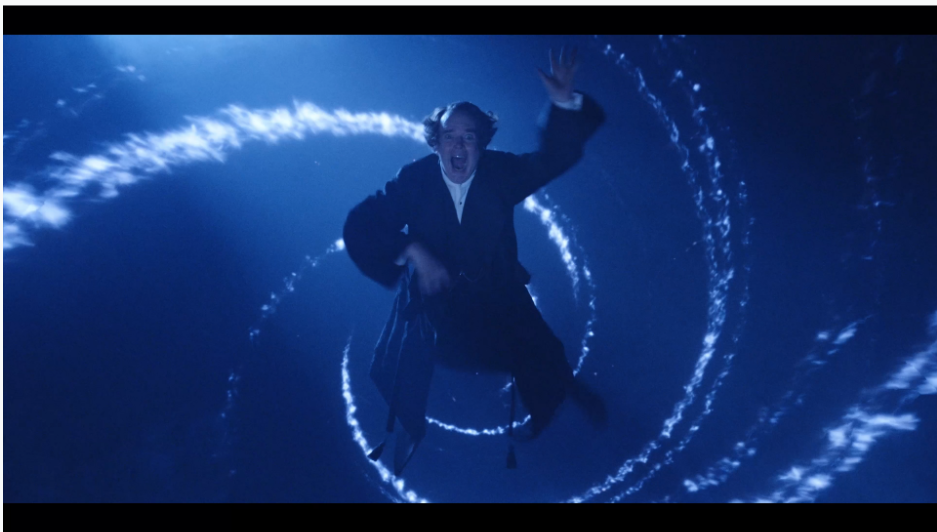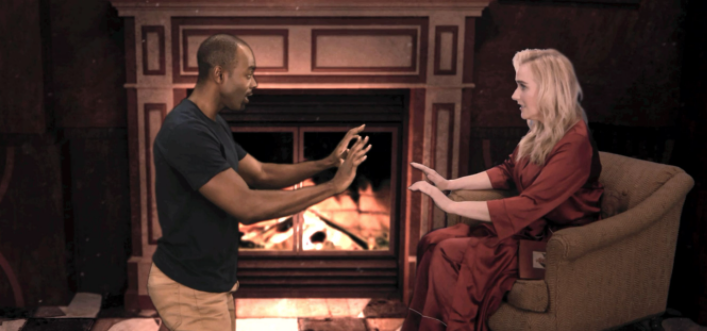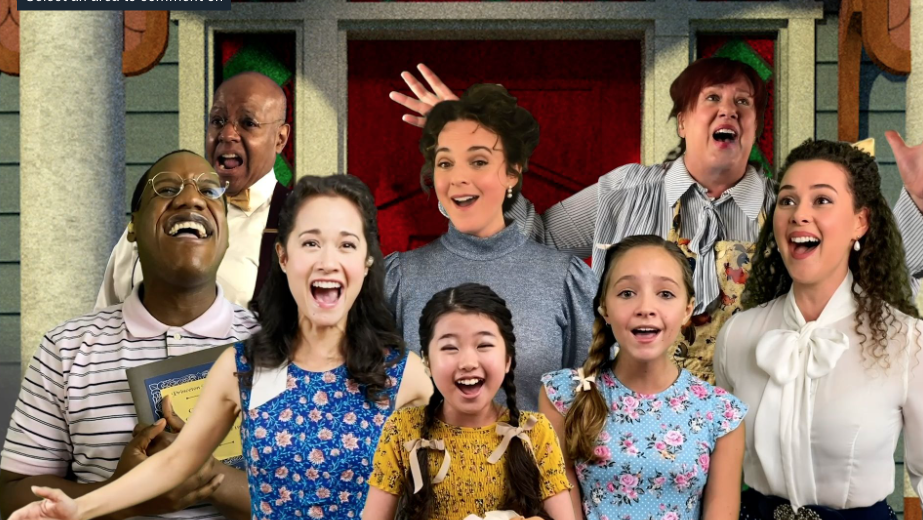By HARRY HAUN

Pandemic or not, the year-end visitor New York can always count on is A Christmas Carol, and, sure enough, two largely unmusical editions of Charles Dickens’ holiday ghost-story will waft forth this year.
One is a virtual reading, directed by Theresa Rebeck and streaming Dec. 16-20 to benefit Primary Stages. A supporting cast of seven will surround the show’s principal “Bah! Humbug”-er, Raul Esparza (premiering Dec. 18 and continuing thru Dec. 22).


The other, now till Jan. 3, is a filmed version of a production that Michael Arden staged last year at L.A.’s Geffen Theater, starring Jefferson Mays, safely distanced by the fact he plays all 50-plus parts. Mays won his Tony playing all 40-plus parts in I Am My Own Wife, so this is a stretch. Basically, it’s the stunt Patrick Stewart pulled on Broadway in 1991 to win the Drama Desk Award for Outstanding One-Man Show.


Currently streaming is a gender-bending, modern-dress, new-musical version of A Christmas Carol. Betsy Wolfe has the title role of Estella Scrooge, the great-great-great-great-granddaughter of you-know-who, a Wall Street tycoon with an inherited penchant for foreclosure who heads for her hometown to shut down and take over a welfare hotel run by an old beau (Clifton Duncan). During a long, sleepless night, she is visited by three spirits—a Miss Havisham (Carolee Carmello), patriarch Ebenezer (Danny Burstyn) and Mr. Merdle (Patrick Page). This is the first digital theater piece filmed entirely during the pandemic, observing all the safe-distancing rules and utilizing cutting-edge technology to look like a film exercise.
Music usually accompanies Christmas Carols. Last year the one that director Matthew Warchus brought across the pond from his Old Vic Theater was steeped in traditional trim—vintage songs that invited audience singalongs. Campbell Scott had his old man’s role (George C. was a deliciously malicious, Emmy-nominated Ebenezer Scrooge in a 1984 TV-movie), while Andrea Martin and LaChanze were Spirits of Christmas Past and Present, dispensing little bags of tasty English cookies to the audience.
Madison Square Garden played host to A Christmas Carol for a decade of December gigs (from 1994 to 2004). It had music by Alan Menken, lyrics by Lynn Ahrens, choreography by Susan Stroman and book by Ahrens and director Mike Ockrent. The latter was putting the finishing touches on the 1999 version when he died of leukemia at age 53. That production—and all of his other Carols—were taken over by his widow (Stroman). Of the 19-song score, the showstopper was the insistent “Link by Link,” shuffled out into a production number by the Ghost of Jacob Marley (Paul Kandel). A smorgasbord of talent took on the role of Scrooge. Terrence Mann, Tony Randall, Hal Linden, Roddy McDowall (in his last role), F. Murray Abraham, Frank Langella, Tim Curry, Tony Roberts, Roger Daltrey and Jim Dale all gave it a go.
Scrooge as a contemporary Harlem slumlord (in the form of Gregory Hines) surfaced fleetingly at the Winter Garden in the winter of ’79, opening five days before Christmas and closing 45 performances later. Larry Marshall as Christmas Past, Tiger Haynes as Marley in chains (“a one-man chain gang”) and Loretta Devine as the love Scrooge left at the lamppost, were also on board. The show was a reunion for Shenandoah creatives: Garry Sherman composed the music, Peter Udell did the lyrics and, with director Philip Rose, the book. Together, they concocted “Sing a Christmas Song” for carolers and the Cratchits.
A decade later, they reworked the material and gave it a more commercial handle, Christmas Is Comin’ Uptown, for a reprise at Baltimore’s Arena Playhouse. A hefty Benny Pope was Scrooge, belting out “Somebody’s Gotta Be the Heavy” (pre-transformed) and “Have I Finally Found a Heart” (transformed).
Ebenezer is still working Harlem. Crossroads Theatre Company is giving the 2019 archive production of A Christmas Carol in Harlem, starring Charles Bernard Murray as Scrooge, a free streaming now till Jan. 3.
Leslie Bricusse did the screenplay and songs for 1970’s Scrooge (played by Albert Finney), earning double Oscar nominations for Best Song Score and Best Song (a robust little ditty called “Thank You Very Much,” delivered by tenants who thought Scrooge was foreclosing on them on Christmas Day and learned instead he’d considerately expired). A stage version was cobbled together in Britain and sent over here for Broadway consideration, but Richard Chamberlain in the lead couldn’t get it any closer than Chicago.
Bricusse provided the lyrics for another Christmas-set Dickens yarn that did get to Broadway, Pickwick, based on the 1837 novel, The Pickwick Papers. Harry Secombe had the title role and the show’s major musical takeaway, “If I Ruled the World.” Davy Jones of The Monkees got his big break playing Pickwick’s valet, Sam Weller, in Hollywood. “That’s What I’d Like for Christmas” led the seasonal songs.
Secombe had a harder-to-pronounce part (Bioernstjene Bjoenson) in the 1970 movie version of Song of Norway, the 1944 Broadway musical that played with the life and music of Edvard Grieg (1843-1907). Lyricists George Forrest and Robert Wright, who turned Borodin into Kismet, allowed the Norwegian composer the luxury of being sung. One of his posthumous contributions was holiday-trimmed into “At Christmastime.” Toralv Maurstad and Florence Henderson played the screen Griegs, and their movie launching was timed to the launching of a cruise ship, also called Song of Norway. Secombe was quoted as discourteously saying that it was a film “you could take the kids to see . . . and leave them there.”
Lyricist Sheldon Harnick has observed these holidays with three different composers. In Richard Rodgers’ musical, Rex, he had the royal kids of Henry VIII—Edward (Michael John), Elizabeth (Penny Fuller) and Mary (Glenn Close) come together and harmonize with “Christmas at Hampton Court.”
Harnick also got a musical out of Sesame Street composer Joe Raposo: 1986’s A Wonderful Life, which, of course, was short for 1946’s classic Christmas flick, It’s a Wonderful Life, in which a wingless angel named Clarence (Henry Travers) shows James Stewart what the world would have been like without him. Good and welcomed as it was, it didn’t get beyond the Paper Mill Playhouse, hopelessly bogged down in a dispute over stage rights. That was then. Evidently, those concerns cleared up because Sir Paul McCartney is said to be composing a score for the show, which will world-premiere in London next year.
With his regular composer, Jerry Bock, Harnick musicalized yet another movie for the stage–1940’s The Shop Around the Corner. Re-titled She Loves Me, it told of a couple of antagonistic shop clerks who, unwittingly, become amorous pen-pals. One energetic production number, “Twelve Days to Christmas,” shows the steadily besieged sales force of Maraczek’s Parfumerie contending with the daily onslaught of Christmas shoppers. It was the last thing that Carol Haney (of Pajama Game fame) choreographed.
In their only Broadway musical, Burt Bacharach and Hal David worked up a holiday frenzy that’s a good gobble away from Christmas. “Turkey Lurkey Time,” choreographed by Michael Bennett, gets danced to distraction by Donna McKechnie, Baayork Lee and Margo Sappington at a rowdy Christmas office party.
Eleven years earlier, Bennett was one of the dancers among the squad of Santas squatting and Cossack-kicking in the frenetic first-act finale of Subways Are for Sleeping. Another Michael (director-choreographer Kidd) blocked the number out in chaotic clusters. Dressed as a Community Chest Santa Claus, Sydney Chaplin starts the song like Henry V before the Battle of Agincourt, pep-talking his similarly suited, bell-ringing troops, urging them to embrace the spirit of the season and “Be a Santa.”
Here’s Love led off with a Kidd-choreographed Macy’s Thanksgiving Day parade, I kid you not. Its cinematic source, 1947’s Miracle on 34th Street, began the same way, with Edmund Gwenn recruited at the last moment to replace a soused Santa on the major float. Not only does he win the Oscar, he is proven in a court of law to be the real Santa Claus. Really. Telling testimony came from R. H. Macy himself (Paul Reed), who sang “That Man Over There” is, indeed, Santa. Should doubt remain, Meredith Willson trotted out a 1951 trunk tune, “It’s Beginning To Look a Lot Like Christmas.” The defense rested.
Some Broadway tunesmith make Christmas synonymous with an ideal that will get people through tough times. “We Need a Little Christmas” is what Jerry Herman prescribed for his freshly fired Mame (Angela Lansbury) and her household. Similarly, at the end of The Best Little Whorehouse in Texas, when the notorious “Chicken Ranch” is shut down and its chicks are scattered to the four winds, Carol Hall offers a “Hard Candy Christmas,” in which they review their unpromising “I’ll Get By” options.
All the seasons were covered in the 1944 movie, Meet Me in St Louis, but two and a half minutes of song make it a beloved Christmas film. That would be Hugh Martin and Ralph Blane’s “Have Yourself a Merry Little Christmas,” sung by Judy Garland to console her little sister, Margaret O’Brien. Originally, it began grimly: “Have yourself a merry little Christmas / It may be your last / Next year we may all be living in the past.” Garland refused to sing that, considering it a cruel way of comforting a little sister and envisioning audiences fleeing the film. The new, immensely improved lyrics are the ones you know and love: “Have yourself a merry little Christmas / Let your heart be light / Next year all our troubles will be out of sight.”


That show’s 1989 Broadway version gets a streaming revival now thru Jan. 2nd by Irish Rep. Its artistic director, Charlotte Moore, who did the Mary Astor role, is directing Melissa Errico in the part.
The granddaddy of all Christmas songs, “White Christmas,” was written for one Bing Crosby movie (1942’s Holiday Inn) and reprised in another Bing Crosby movie (1954’s White Christmas), and stage facsimiles of both films made it to Broadway in 2008 and 2016. Crosby’s record of it became the best-selling single of all time—until “Goodbye, England’s Rose,” Elton John’s reworking of “Candle in the Wind” done for Princess Diana’s funeral. Irving Berlin won an Academy Award for it, and, in a fluke for the Motion Picture Academy, he got to announce himself the winner, sneaking a cautionary peek inside the envelope first and then declaring, relieved, “This goes to a nice guy. I’ve known him all my life.”
“White Christmas” started eight years earlier with “Easter Parade,” which Clifton Webb and Marilyn Miller introduced on Broadway in a Berlin revue called As Thousands Cheer. It set the composer to thinking about writing a song for all the holidays and having an inn open only on those holidays to present them. He passed that premise along to Pulitzer Prize playwright Elmer (Street Scene) Rice, who ran with it. Both were nominated for a writing Oscar for Holiday Inn. The Connecticut farmhouse/nightclub on Paramount’s backlot used for the film was recycled 12 year later for White Christmas and givem a Technicolor paint-job to look like a very musical Vermont ski-lodge.
“Be Careful, It’s My Heart” was expected to be the big hit to come out of Holiday Inn. Crosby wasn’t particularly impressed with “White Christmas,” when Berlin played it for him during rehearsals. He received it matter-of-factly and said, “I don’t think we’ll have any problem with that one, Irv.”

















